#flint knapping
Explore tagged Tumblr posts
Text


Come experience the wild arts known as Bushcraft. At the gateway gallery in ocotillo. This Summer event will dive into traditional arts and crafts, covering subjects from Flint napping to basket weaving. Seating is limited so reserve your spot to gain this access to 30 years of knowledge and experience in the comfort of an air condition studio! For more information please visit gateway gallery on Instagram or eventbrite.com
#art of bushcraft#outdoorlife#outdoors#bushcraft#art#my art#flint knapping#artists on tumblr#rockclub
13 notes
·
View notes
Text

Prehistoric Arrowhead, Dales Countryside Museum, Hawes, Yorkshire Dales
#ice age#iron age#bronze age#stone age#prehistoric#prehistory#neolithic#mesolithic#paleolithic#archaeology#arrowhead#prehistoric tools#prehistoric weapons#arrow#flintwork#flint knapping#Yorkshire Dales
167 notes
·
View notes
Text



one of the students showed us a (broken) axe that he found *o* it's striped flint but you can't really see it. wow, it's so sharp.... so perfect
6 notes
·
View notes
Text
Sensing Morren
Sight
Blue Celtic design tattoos from her left shoulder to the back of her right hand
Hip-length dark brown hair usually worn as a single long braid
Freckles, very abundant
Golden yellow eyes which don't seem entirely human and reflect in the dark
Green cloth tunic, trousers, and cloak, fur boots and leather breastplate, bracers, and kneepads for armour
Bare feet when in camp
Unafraid of showing skin or even being nude around others
Average height
Smiles easily when comfortable
Very faint scars on shoulder (three claw marks covered by her tattoo) and hands (various small nicks)
Curled into herself when sleeping
Sound
Slight lilt when speaking
Non-human growls when angry or trying to be intimidating
Quiet footsteps
Sound of stone being clicked together as she knaps flint
Soothing tone when she is healing
Breathy laughter
Smell
Petrichor - especially when she has just used magic
Loam
Pine
Fur
Floral/herbal scents from her herb pouch
Touch
Calloused hands
Lean muscle under soft skin
Light, reassuring touches to the back of the hand
Bumping her head against someone's shoulder
Spooning
Taste 😉
Stolen from @nekrotisch who also stole it from @blyghthound
4 notes
·
View notes
Text
Imagine being a human in the middle Paleolithic. You don't even know what Indonesia is, much less that part of it just exploded. All you know is that the sun's going out. Every year there are fewer edible roots in the ground, less fish in the streams, and the deer get thinner and more skittish--just like you. You don't know how to farm grain or domesticate animals; every day is a desperate search for enough calories to survive. You might think your little community is the last group of people left in the world, and you're not far from wrong. Humanity is an endangered species, hovering so close to the brink of extinction that people in the future will be able to see the struggle written in your genome.
But you don't stop struggling. You endure. You hunt, you gather, you dig in the dirt and fight other humans and fuck other humans and teach your children to do the same. You do anything necessary to stay alive and protect everyone around you--and you find any little moments of joy you can. You hold your partner. You play with your kids. You try to create interesting rhythms when you're knapping flint, and soon the rest of your family starts joining in. Maybe you wonder if someday, the world will be a better place--but you know that it only matters if you or your children or your children's children live to see it.
So you keep going. Even when it's hard, you keep going. Even when it hurts, you keep going. Even when you're cold and hungry and tired--which is all the time--you keep going. Even when you're not sure you'll ever see a clear sky again, you keep going. And when you finally die, your kids keep going. They stay alive, and they find happiness, and they teach their children the lessons they learned from you.
And then, one day, decades after you've died, it starts to get warmer. The wolf your great-grandson has been throwing scraps to finally comes close enough to lick his hand. That green rock your great-great-great niece used to build the fire pit has turned into a shiny sort of leaf that's harder and sharper than flint. It's still tough, and sometimes your descendants are still hungry, but they're getting stronger, and they have more time to think and play--and now they're not just breaking rocks to make handaxes and arrowheads, but to make images of things they've seen. And they don't know it, but that's making them smarter, and more creative--they're starting to talk about concepts you physically couldn't have understood. They're living longer, healthier, happier lives, and imagining even bigger and better things--and someday, their descendants will have the power to make them.
And none of it would have been possible if you hadn't kept going.
It gets better. Don't give up. Don't let go. Rage against the dying of the light--because someday, there will be another sunrise.
7 notes
·
View notes
Text
nine's list of skills that the vestiges are teaching him
First, Second, and Third, Shigaraki Yoichi, Kudo, and Bruce
encrypting and coding
gun
hand-to-hand combat
actual war strategy
Fourth, Shinomori Hikage
Wilderness survival (how to make clean water, how to make basic tools/weapons, how to make temporary/semi-permanent/permanent structures, how to build a fire, how to make pottery, how to carve wood, how to flint knap, how to navigate both with and without a map/compass, how to navigate by the stars)
Cooking (how to butcher/skin animals, how to properly smoke meat, how to tell if you can eat that plant, how to properly store and preserve food, how to make pine tea for vitamin c)
Natural poisons/venoms (hemlock, foxglove, nightshade, azalea, ivy, mistletoe, rhubarb, yew, snakes, fish, frogs, rays, skates, spiders)
Geology, natural history, palaeontology (for some reason??), anthropology
Hunting, fishing, gathering berries/nuts/roots, mushroom hunting
Fifth, Banjou Daigoro
gymnastics
free running
parkour
mathematics degree (??? i didn't know he could DO that)
Sixth, Tayutai En
lockpicking
stealth
fucking hatchets apparently??
ethics and philosophy, sure why not
Seventh, Shimura Nana
how to fly
HOW TO LAND
throwing knives
english
SWORDPLAY YO
hey why is fourth's the only one thats capitalized? Because he insisted. Thank you. Nine I was going to teach you how to land either way, you didn't have to make it another point. real question id why me 2nd & 3rd are all put as one? Look, given how you all act I have no real way of knowing. Okay, but why are we all stuck together then, Nine? 3 dont talk like u h8 me pls Use grammar and I might. no. Then suffer. Why isn't Eight on here? cant afford him lmao none of you are allowed in my documents anymore.
#bnha#one for all#one for all vestiges#shimura nana#tayutai en#banjo daigoro#shinomori hikage#shigaraki yoichi#midoriya izuku#bnha kudou#bnha bruce
38 notes
·
View notes
Text
youtube
Cherokee Traditions : Flintknapping
from Visit Cherokee Nation
80 notes
·
View notes
Text
Flint knapping and practical magic
Now that we have discussed the basics of history and properties of flint, how can flint knapping be used in practical magic?
First, a few disclaimers:
1. Please do not try this indoors, without proper protective equipment
2. You will need some thick gloves- leather or gardening gloves that are designed to prevent cuts.
3. Protective eye gear is essential, especially when you're learning (which I'll admit I still am)
4. A thick towel on your lap will help prevent you bruising your legs as you work (I have done that before)
5. I am not an expert, this is just me sharing why I think more people should learn about flint knapping and magic. Please watch more detailed tutorials before attempting anything. It evolves sharp edges and the possibility to accidentally start a fire if you do it wrong.
That being said, hopefully I haven't scared too many people off. I am not a dextrous person myself and I have managed to do some rudimentary knapping, I even created a flint crow statuette. The tools that you can make can be extremely useful for Witchcraft, a handaxe for example can be used as an alternative to a ceremonial dagger. I use my flint tools for wood carving, simple stuff like creating touchwoods and small things. Another use if you're an artist is as a charmed pencil sharpener, to add some intention and protection from your ancestors into your work. But I am getting ahead of myself
How to find flint
Finding flint depends on your geographical location. For me, i collect flint from my family home in the east of England. East anglia is rich in flint and chalk as well as clay, anywhere you go you will find big chunks of flint on the ground. Look up your local area's geological background and this will help determine where you can find flint- in volcanic areas you are more likely to find obsidian than flint! Which is very cool, I'm jealous of you. The beach, however, is generally the best place to start wherever you are:
Look for large grey or white stones, flint generally has a coating of sedimentary rock.

It is especially fun to look for rocks with cracks down the middle that go all the way around- as they often have deposits inside. If you're not sure if it's flint, you can hit it with another rock on the beach (another HARD one, using chalk or sedimentary rocks will just break the chalk open.) And if it is flint it will shatter into pieces. Again please be careful. I like to chuck them a good deal away to open them up, and let gravity do the work when it hits other stones. A newly opened egde will look something like this:
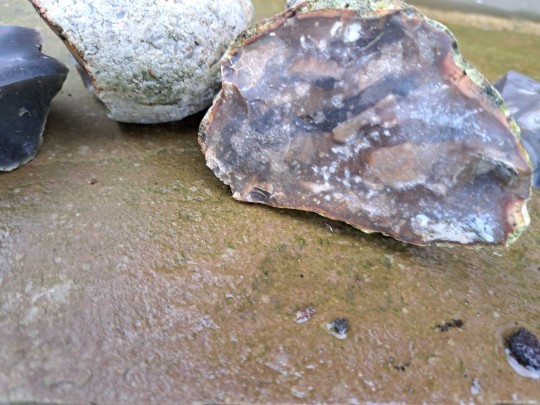

The usual shine of flint tends to mattify on a fresh edge, but it still very smooth. When flint is being used as a brick to build a wall, this is as far as knapping goes. But for someone trying to make tools, you need to break it up again into smaller pieces.
For me, I just like breaking stones apart. I find it very therapeutic apart from the magickal elements. There is, however, something unquestionably magical about sitting outside and breaking open a stone, slowly learning with the gentle and rusty hand that a child in the stone age might have had. When I first did this, after watching an episode of digging for Britain, I had the genuine feeling that the people of the past were guiding my hands, teaching me how to work. It is an excellent, practical way to get closer to your ancestors during ancestor work.
I don't tend to worship my ancestors, but I do certainly lean on some of them for advice and guidance in times of strife.
Anyway, when you have a piece like this

On the further edge you can see that there are jagged edges where it has been knapped unevenly. This is a good way to get a sharp edge: you tap with another rock that is roughly the shape of your hand several times and eventually the flint will give. Here it broke into three pieces:

The iron deposits make this rock a slightly unusual one, but the principal applies for any piece of flint. Here it is especially important to be careful and wear gloves (in the picture I'm not wearing gloves because I'm a dumb dumb who cut my hand after this).
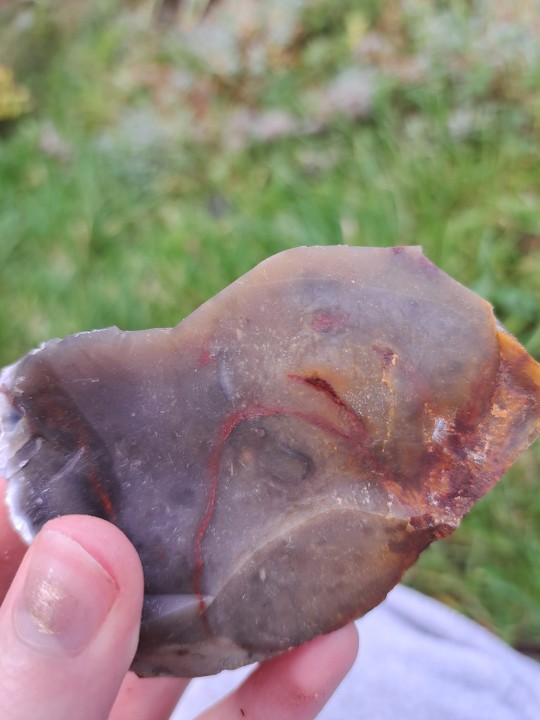

This piece is essentially a knife. You can see the slightly transparent edge, serrated. Generally an antler or bone would be used to shape this piece further. (I used chewed up antlers from the family dog)
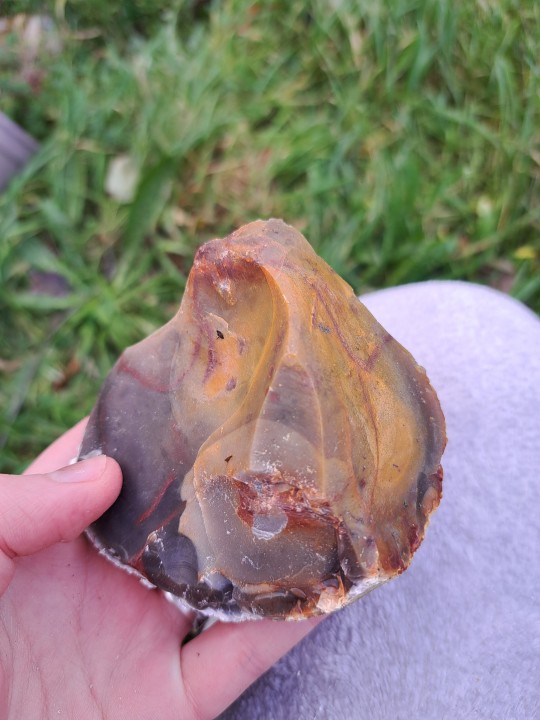
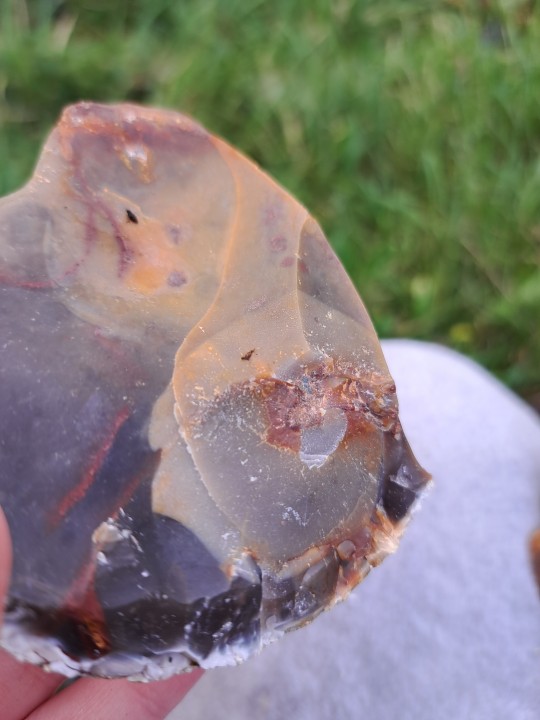

You can see on the picture to the left there are cracks running down the larger piece. You can carefully remove a smaller piece from the larger by hitting it a few times with the same rounded stone, acting as your hammer. Here a piece came off that could be easily shaped into an arrowhead.
Laver flakes are created by hitting a larger piece precisely until a small, sharp flake falls off. These are difficult to do for beginners. Most of these sharp pieces shown are now on my altar, to add protection to the space and connection to my ancestors. Razor sharp small flakes have a tenancy to fall off, I collect these in a jar and use them for spell bags and jars. It is important to not leave them on the floor anywhere where pets walk, as they will cut into their feet. (And yours if you have a habit of walking barefoot in your garden/outside).
The best part about flint knapping in magical practice is that it's entirely free. Like I've said before, some of the best magical tools come not from commercialised stores but through your own practice and historical techniques that never required buying materials. Go forth and Forage, my flintlings.
For more information and a more detailed guide on things I can't do, check out this website:
https://exarc.net/issue-2016-3/at/recycled-flint-cores-teaching-tools-flintknapping-archaeological-open-air-museums
This YouTube video is also helpful:
Wessex archaeology flint knapping basics
25 notes
·
View notes
Text
Types of outdoor survival guys:
Survivor Guy
"This is the way humans were MEANT to live!" (Absolutely Not)
Lives and dies by his bow drill firestarter
Do it alone to prove something (not sure what, but do your thing, buddy)
Ironically the type of guy most famous for... not actually surviving
Vision Quest Guy
The whitest kind of guy
"Something something the transcendent experience of communing with nature"
"An old Indigenous guide once told me [insert Billy Graham quote here]"
Won't stop climbing into caves
Some kind of fabric tied around his head
"Man the Hunter" Guy
Beautiful and inherently useless flint-knapped knives
"Primitive Skills" (I literally hate this term with every fibre of my being)
Caught a squirrel one time and now believes he can "live off the land"
Why are you not wearing a shirt? The woods are COLD, dude
Super Adventure Guy
"It's not actually that far down, maybe like 1500 feet?"
Has broken so, so many bones
Somehow the guy least likely to die or disappear before you hear about him
Seriously dude, how are you still alive??
Experimental Archaeology Guy
Just the most unhinged man you've ever met
Thinks hunting goats with a stone spear is a polite dinner conversation topic
Indiana Jones couldn't get ethics board authorisation but somehow this guy can??
Has 3 atlatls and knows how to use them
Boy Scout Guy
No fewer than 3 types of firestarter on him every time he leaves the house
Can make a shelter out of literally anything
Infodumps constantly. Dangerously close to mansplaining for most of it
Could give a lecture on field first aid with no prep at all
Passes out at the sight of his own blood
Weekend Warrior Guy
"I saw this on TV once!"
Has every single outdoor survival gadget
Backpack weighs more than he does
All his co-workers know exactly where he was and what he did there last vacation
Carries a machete for some reason
German Tourist Guy
"Just let me park here for a minute, I need a selfie with that bear."
"Something something conquering the forces of nature"
The most expensive hiking boots you've ever seen
You're more likely to spot this kind of guy in the Canadian Arctic than polar bears and caribou combined
Outdoorsy Chick Guy
20-minute monologue about the importance of teaching your daughters they can do anything a boy can
Pink camo
She's probably a bow hunter
Medicinal plant enthusiast (accuracy not guaranteed)
"Men are crybabies, this is So Easy!"
#outdoor recreation#based on a) outdoor survival media and b) several years of outdoor rec courses#I'm not even trying to be mean I just know so many of these guys#quite iften you get the outdoorsy chick/vision quest guy combo but they don't really need their own category here#can you tell im watching too much Alone?#can you tell i really want it to be spring now so i can embrace my worst outdoors guy traits?
42 notes
·
View notes
Text

Party all night, knap all day
85 notes
·
View notes
Text

Rainbow Obsidian Rough


Large Obsidian
#obsidian#flint knapping#stone aesthetic#special collections#collectibles#crystals#geology#gemstones#rocks and minerals#crystal collection#natural rock#lapidary rough#agate#lapidary#gemstone#crystal#home decor#home#home & lifestyle#natural decor#rainbow obsidian#geology rock#geology rocks#cool rocks#minerals#earth science#rocks#rock hounding
19 notes
·
View notes
Text
Put some stone blades in a folding knife
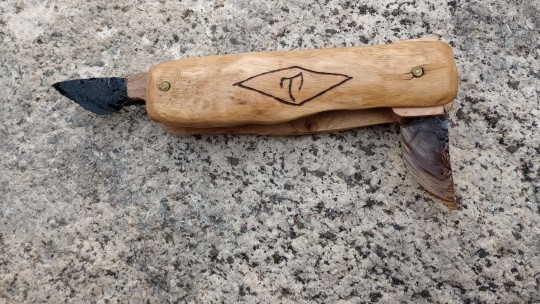
#art of bushcraft#outdoorlife#outdoors#bushcraft#my art#ways of old#art#flint knapping#knapped knives#folding knife
70 notes
·
View notes
Text


Neolithic Axe Collection, Stranraer Museum, Scotland
#ice age#bronze age#iron age#stone age#prehistoric#prehistory#neolithic#mesolithic#paleolithic#archaeology#ancient living#ancient craft#ancient cultures#flint knapping#stonework#axe#prehistoric tools#Stranraer Museum
116 notes
·
View notes
Text

Very beautiful arrowhead. Mierzanowice culture, the first bronze age culture in Poland, so aroind 2200 BC.
#first grave good -_- after 2 weeks. these graves are emptyyyyy and destroyed#moje#my pic#liveblogging#archaeology#arrow head#flint knapping#flint issues#excavations
9 notes
·
View notes
Text


Some stuff’s
#dog talk#flint knapping#archaic human#found a hefty rock and finally got some actual material off of it#rather than just chipping away at stone#I initially wanted this to be a long blade but I misjudged a hit and broke it in half pff#so uhhhhh tiny point-blade it is
2 notes
·
View notes
Text

Bilolissya Culture: this is regarded as just about the earliest typically-Mesolithic flint-knapping tradition, seemingly appearing at the Dryas III-Preboreal boundary in the lower Danube region.
#history#historyfiles#ancient world#archaeology#mesolithic#ancient europe#bilolissya#flint knapping#dryas#preboreal#danube#europe
3 notes
·
View notes